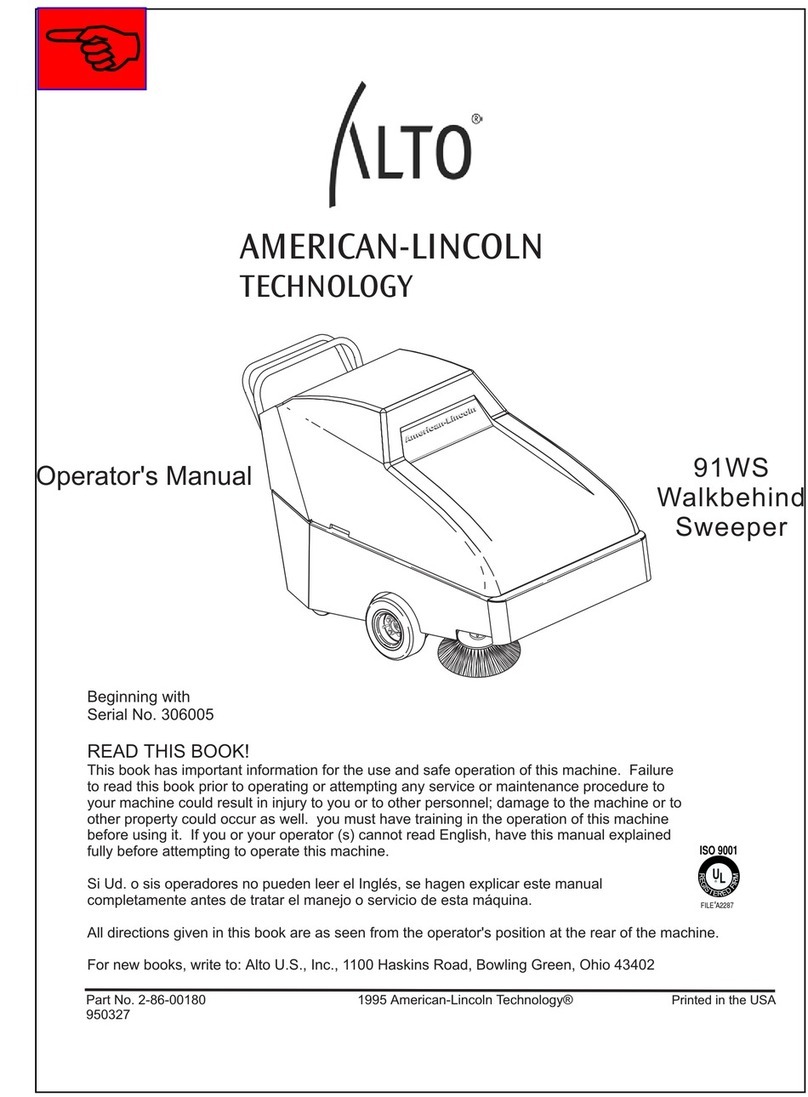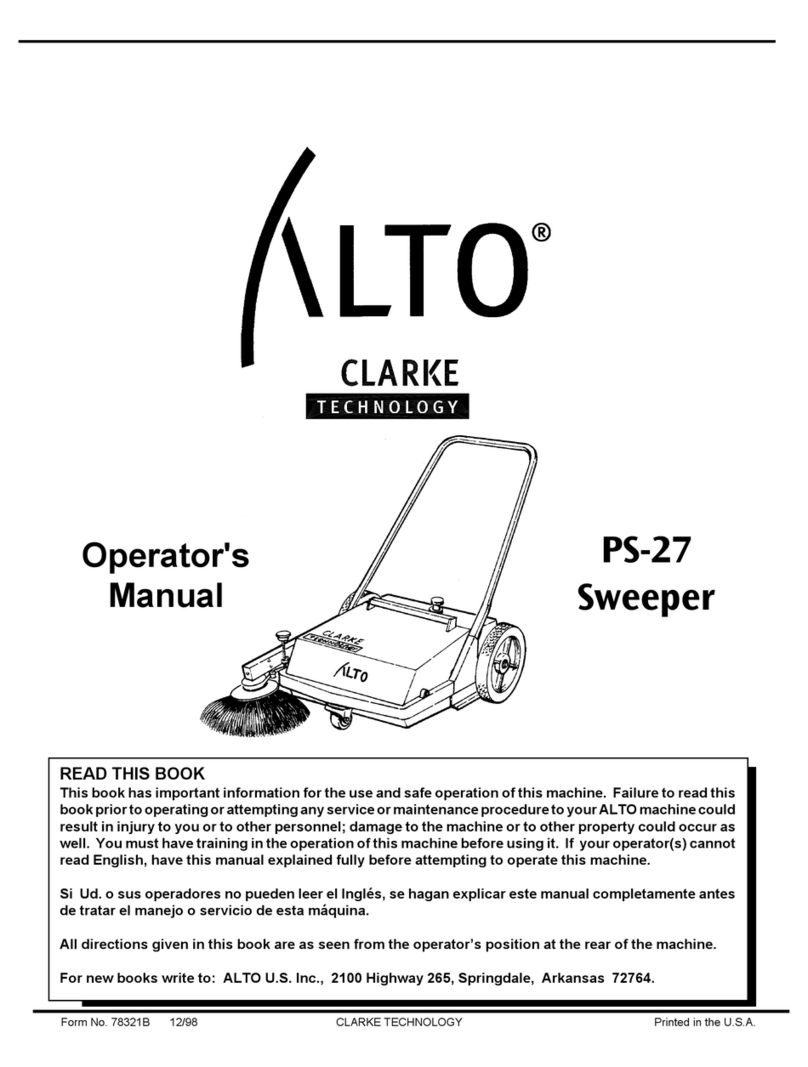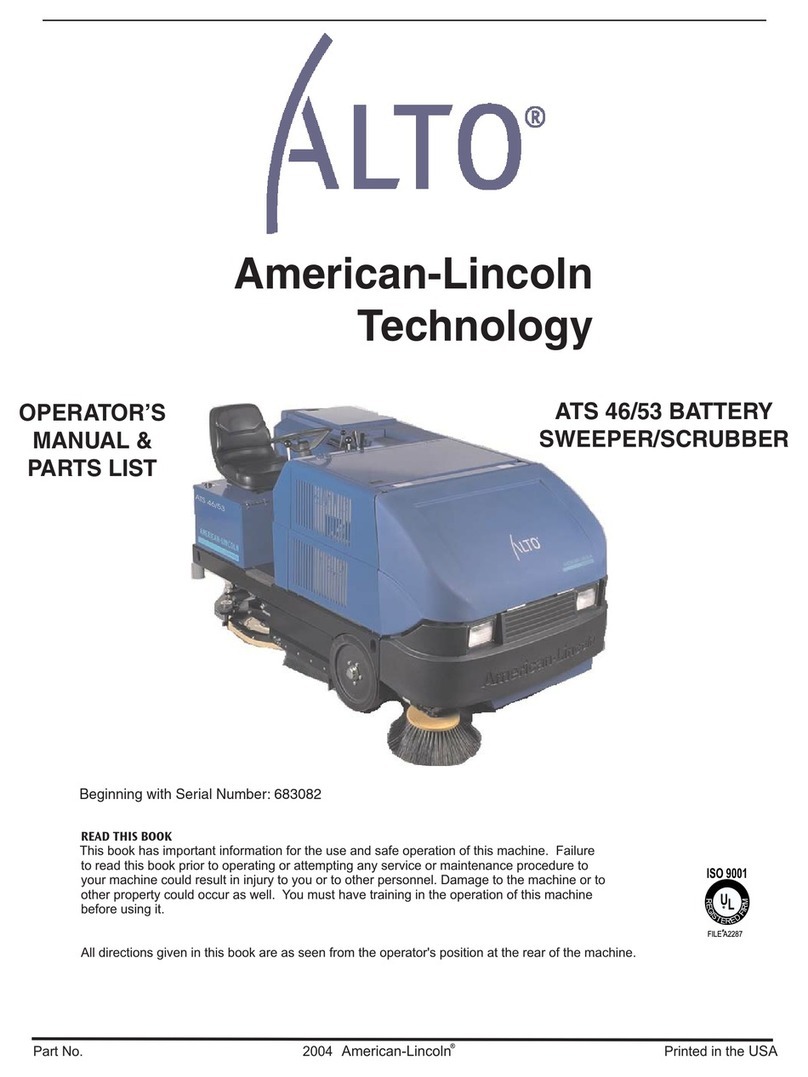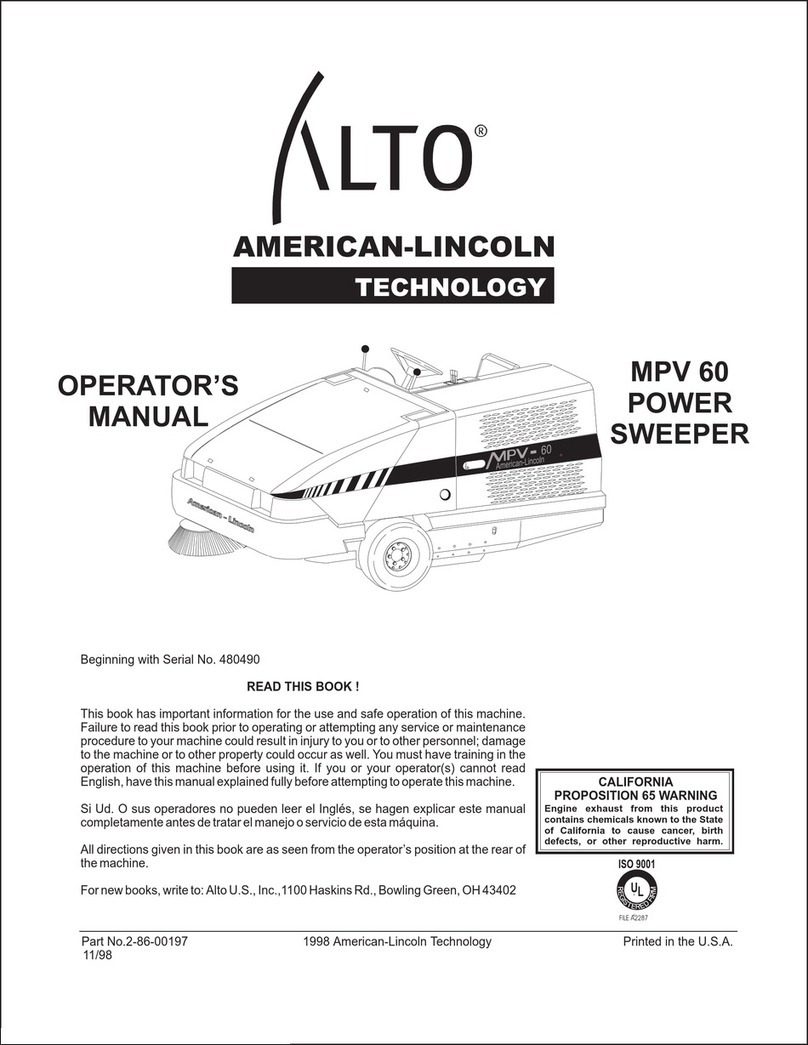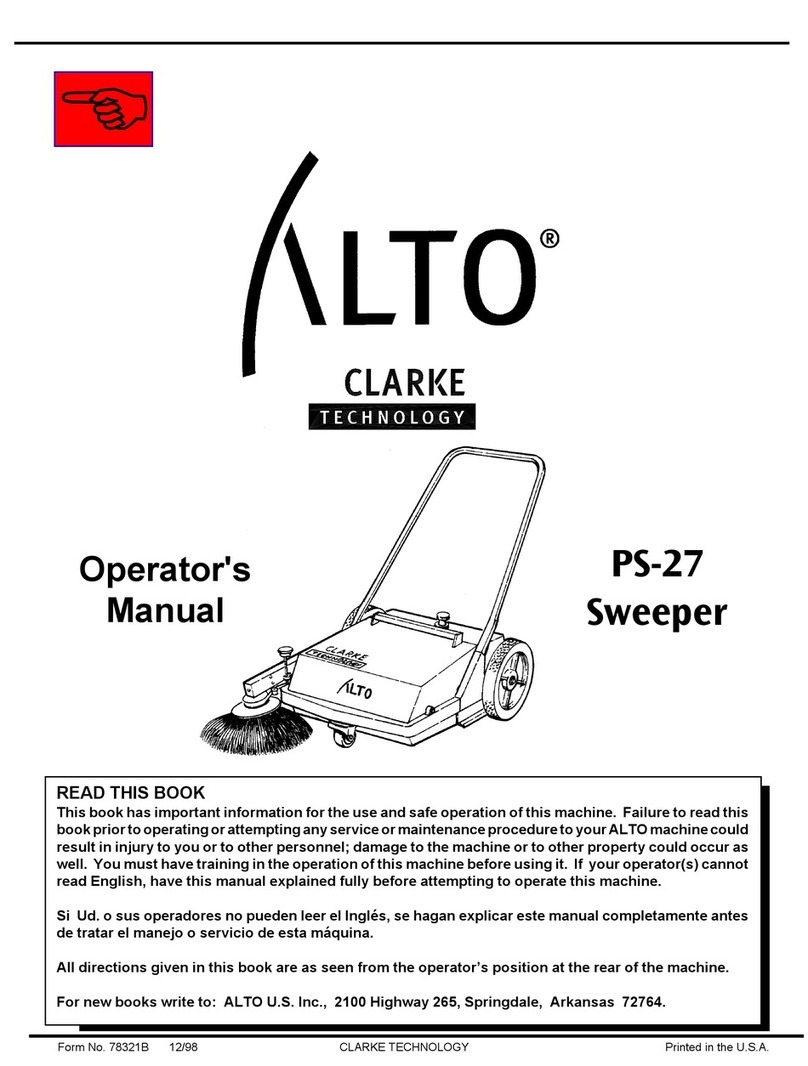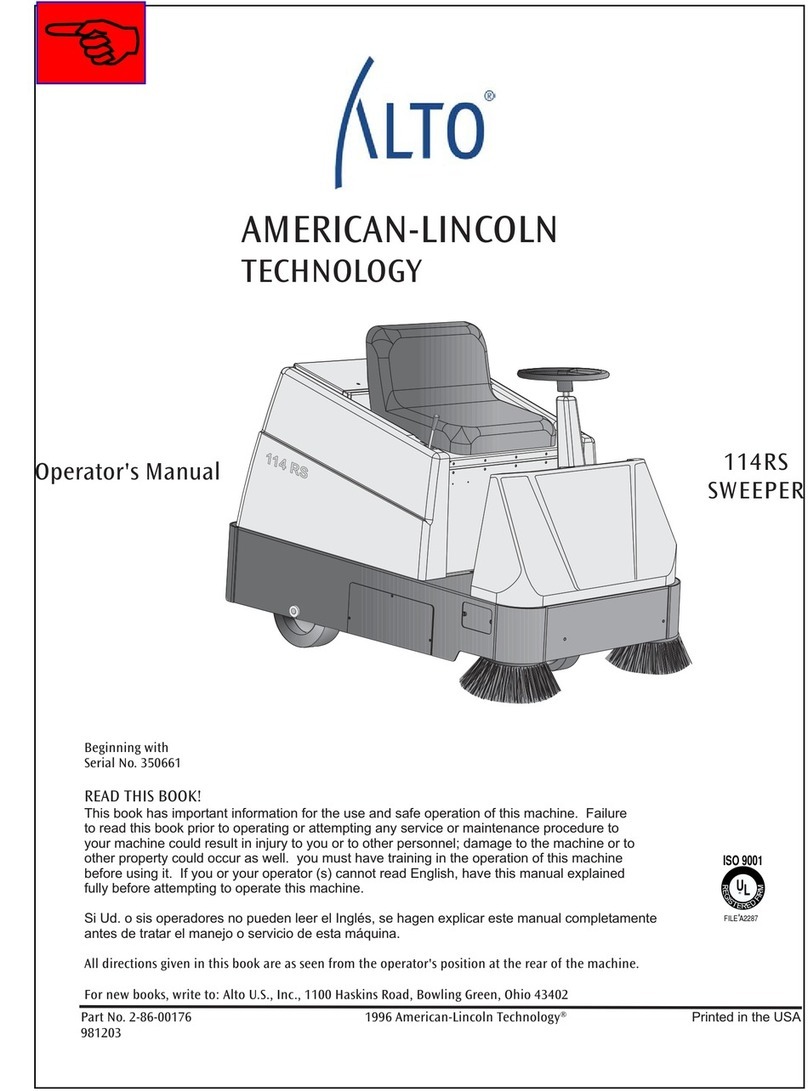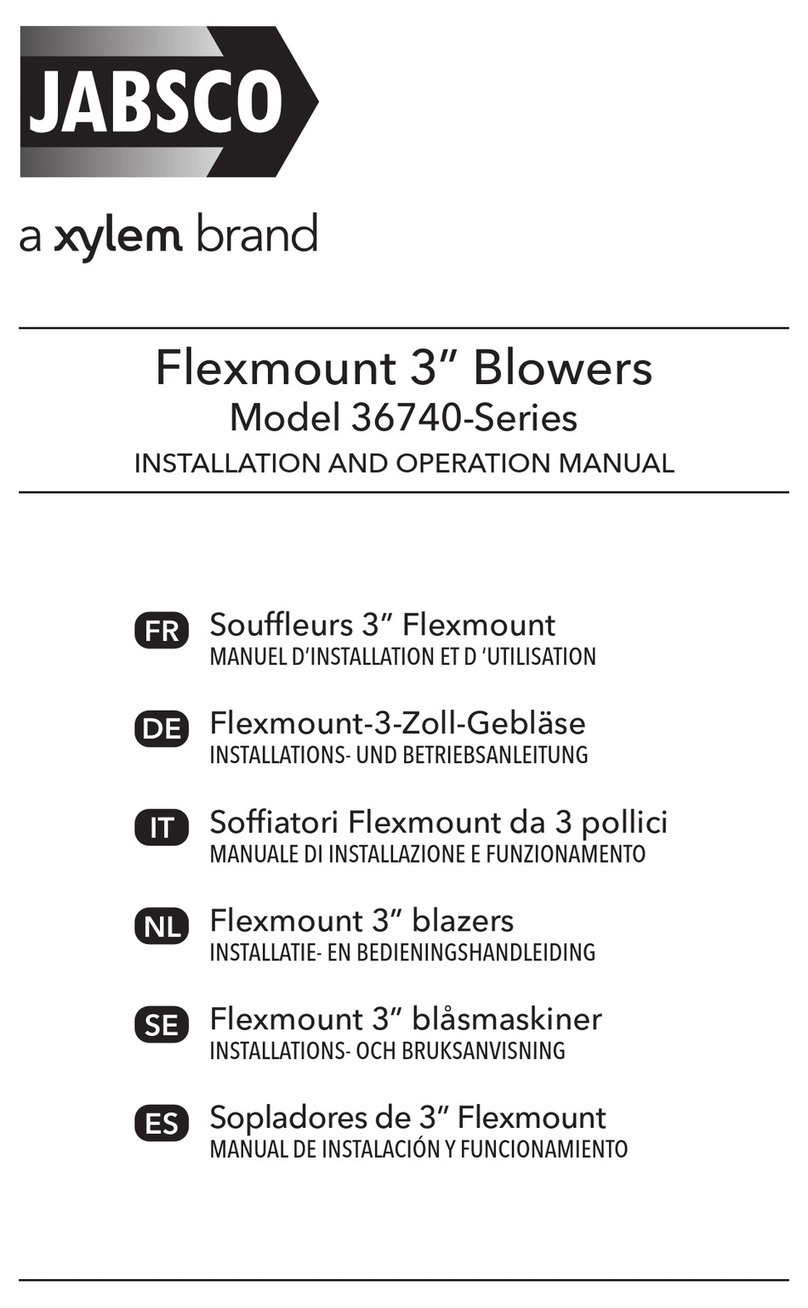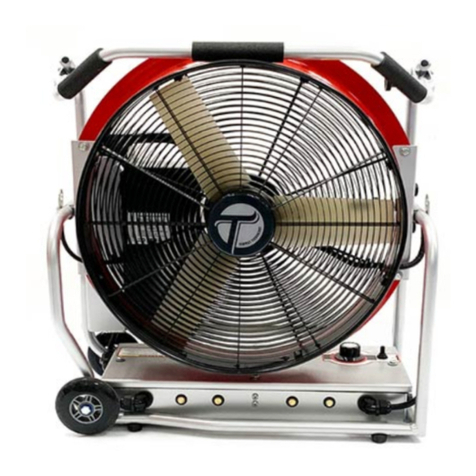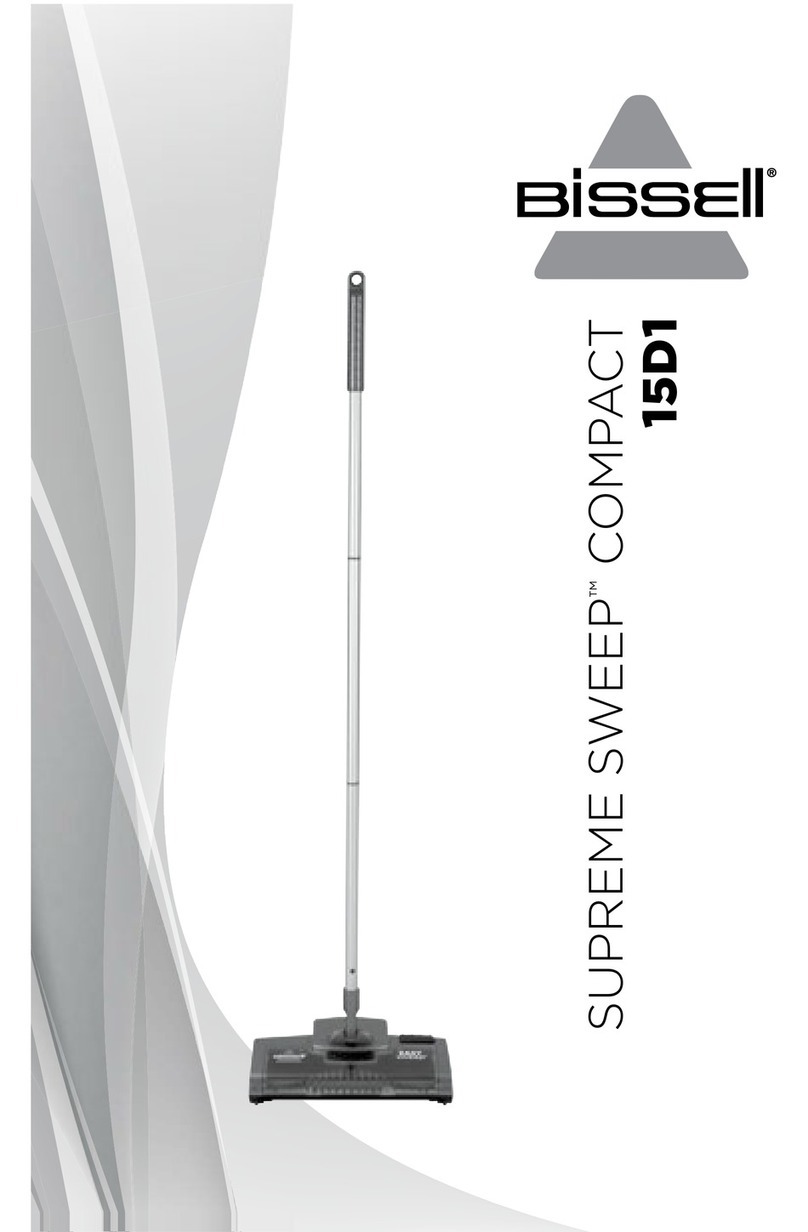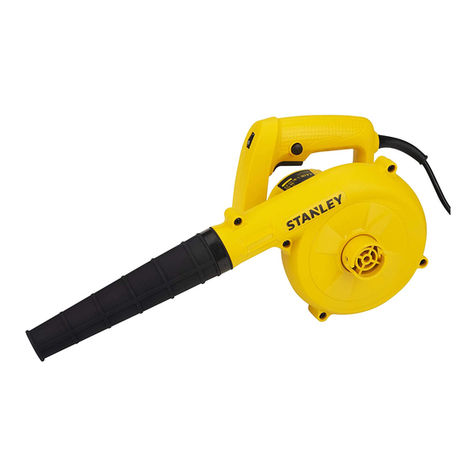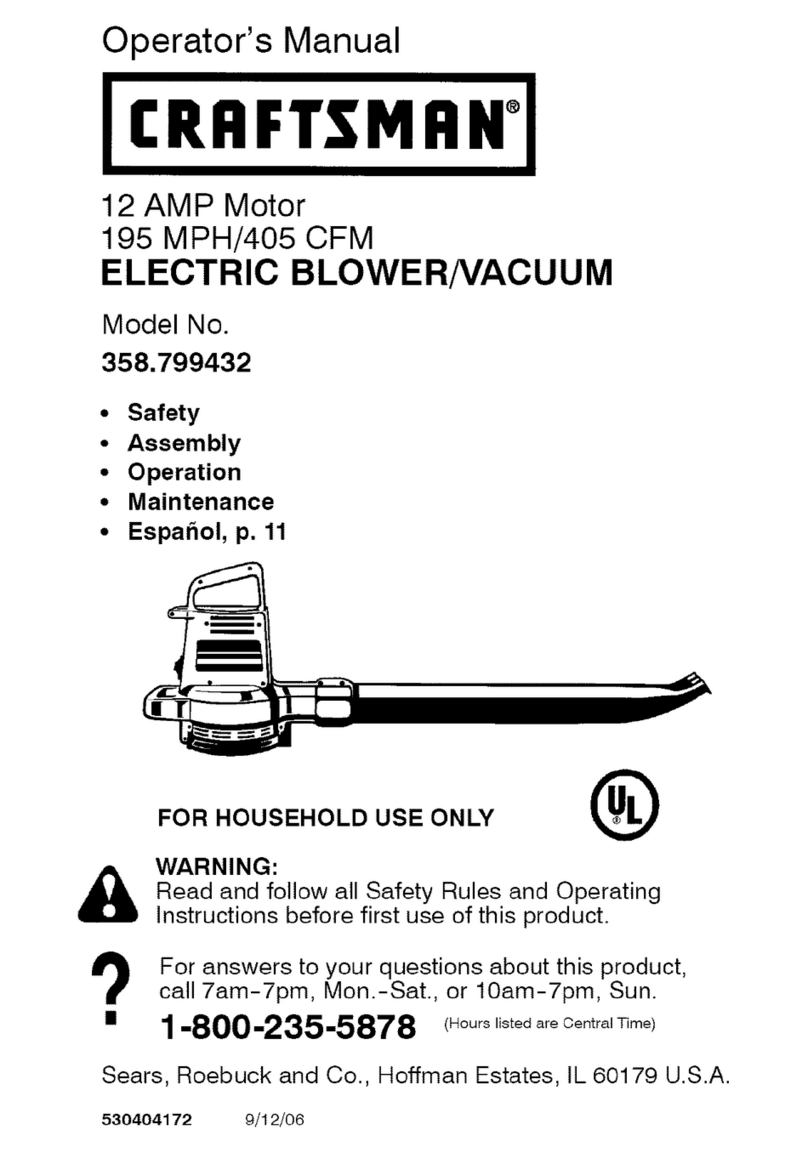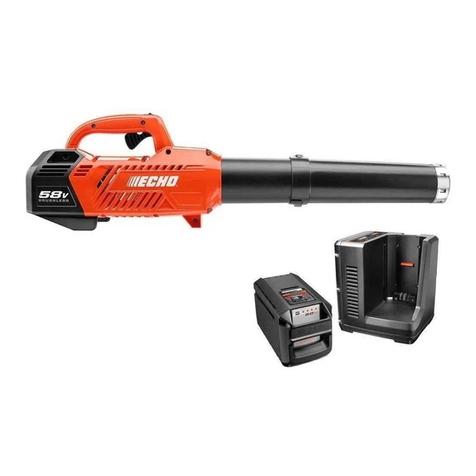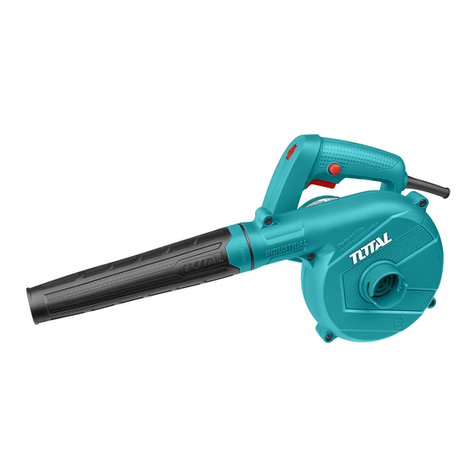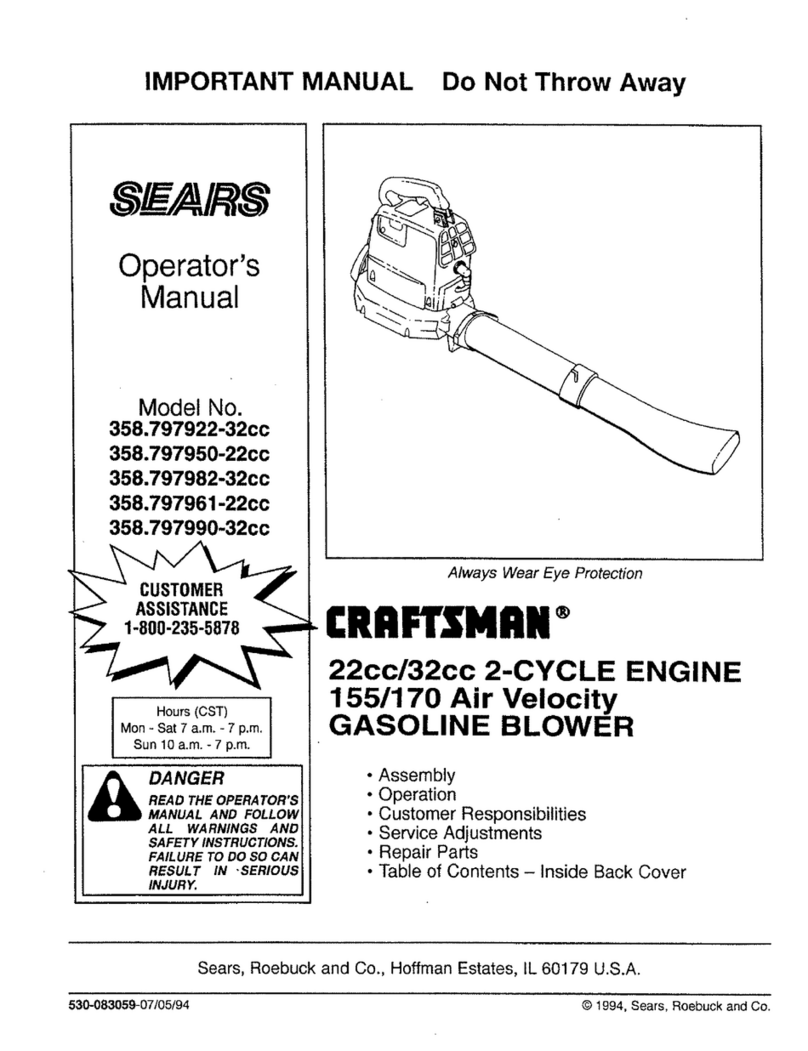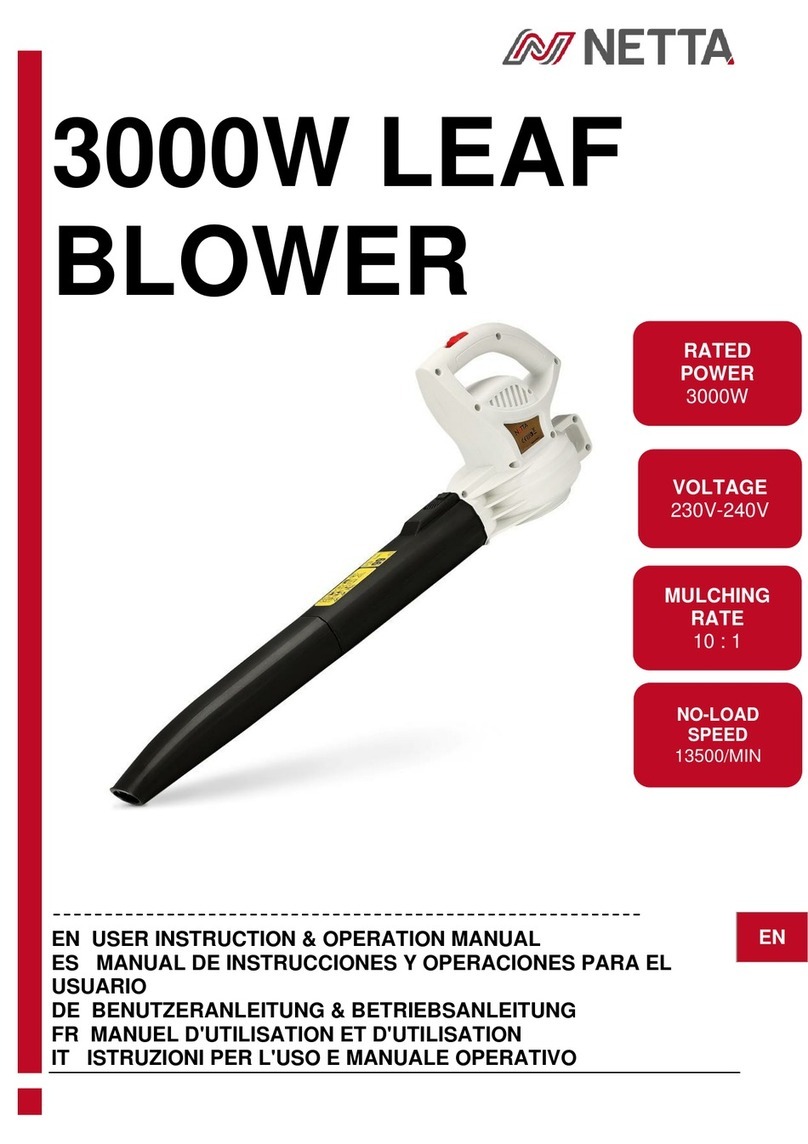Alto 114RS SWEEPER User manual

AMERICAN-LINCOLN
TECHNOLOGY
Electrical
Troubleshooting Guide
114RS
SWEEPER
Beginning with Serial No. 350002
Part No. 2-86-00186 1996 American-Lincoln Technology® Printed in the USA
UL
®
ISO 9001
FILE A2287
#

American-LincolnTechnology 1-1
114 RS Troubleshooting Guide
CAUTION & GENERAL STATEMENT....................................................................................................1-2
MOTOR CONTROLLER.........................................................................................................................1-3
DRIVE MOTOR CIRCUIT....................................................................................................................... 1-4
FOOT PEDAL POTENTIOMETER .........................................................................................................1-5
VACUUM MOTOR..................................................................................................................................1-6
BROOM CIRCUIT ..................................................................................................................................1-7
SIDE BROOM CIRCUIT .........................................................................................................................1-8
HORN, HOUR AND CONDITION METER CIRCUITS............................................................................ 1-9
SHAKER MOTOR CIRCUIT...................................................................................................................1-10
TABLE OF CONTENTS

1-2 American-LincolnTechnology
114 RS Troubleshooting Guide
ELECTRICAL TROUBLE SHOOTING GUIDE
114RS SWEEPER
CAUTION STATEMENT
As with all electrical equipment, caution is essential when troubleshooting. Remove all watches, rings
and jewelry before proceeding. Take precautions when conducting power checks. Take time needed to place
meter leads correctly so as not to short to nearby terminals and/or electrical connections. Do not forget to
disconnect power at the battery when performing continuity checks or damage to your test meter may result.
All troubleshooting should be performed by a qualified technician experienced in DC voltage and DC testing
equipment.
GENERALSTATEMENT
The following guide will present each electrical circuit separately excluding options unless they are in
an electrical series with the standard machine.
1. “Power Off” means key switch is turned off.
2. “Power Disconnect” means battery unplugged from the machine.
3. All voltages are taken with the battery plugged in and the key switch on unless noted otherwise.
4. All voltage readings are taken with the meter (-) lead connected to the battery (-) or the (-) side of the
condition meter unless otherwise specified.
5. All continuity readings are taken with the key switch off and the battery disconnected.
CAUTION & GENERAL STATEMENT

American-LincolnTechnology 1-3
114 RS Troubleshooting Guide
MOTOR CONTROLLER
Verify there is battery voltage at the controller by checking B+ and B-. Place (+) meter lead on B+
and (-) meter lead on B-. If no voltage is present, check the battery voltage and all associated wiring
Turn off power. Disconnect all wires on M1 and M2 (wire #13 & #14) on the motor controller. Connect
(+) of meter to M1 and (-) of meter to M2.
Turn power on. Move the foot pedal to full forward position. The meter will read battery voltage
(approximately +36 vdc). In neutral, the voltage will be 3.3 vdc and in reverse should read
approximately -25.8 vdc.
If no voltage is present on M1 & M2, verify 36 vdc on P1 (pin #6). If voltage is not present, check all
wiring back to the key switch. If there is no voltage on M1 & M2 and there is 36 vdc on P1 (pin #6), check P1.
Remove 6 pin (orange) connector and rotate 90°. Plug pin 6 in only (wire #9A) back into the controller. With
the meter (-) on the negative battery lead, check pins #1,#2 & #3 of P1. Pin #1 should read 0 vdc, pin #2 2.5
vdc, and pin #3 should read approximately 5 vdc. If these voltages are not present, the controller is bad and
needs to be replaced.
MOTOR CONTROLLER
B-
B+
M1
M2
P2
P1
PIN 1
T-0001
T0001

1-4 American-LincolnTechnology
114 RS Troubleshooting Guide
DRIVE MOTOR CIRCUIT
Conditions necessary for circuit to work:
1. Batteryvoltage.
2. Key switch on.
3. CB-1 & CB-6 closed.
4. Solenoid 1A closed.
5. Battery voltage on controller (See Controller).
If the wiring is good and all voltages are present, check the wiring back to the drive motor (wires #13 &
#14). If wiring is good, the drive motor is bad and needs to be replaced.
DRIVE MOTOR CIRCUIT
36V
BANK
M2
P1
M1
B (+)
B (-)
WHT.
DRIVE
BLK.
D1
D5
1C
1
9B 99,9A
7A,7B
233
14
13
12
11
10
7
7,7A
CB-6
25A
CB-1
10A
KEY SW.
1A
1A
MTR.
CONTROLLER
6
3
2
1
PIN
1
2
3
0 VDC
0 VDC
4.8 VDC 4.8 VDC 4.8 VDC
0 VDC
0 VDC 0 VDC
0 VDC
FWD. NEUT. REV.
T-0002
T0002

American-LincolnTechnology 1-5
114 RS Troubleshooting Guide
FOOT PEDAL POTENTIOMETER
Turn off power and remove the foot pedal assembly. Disconnect all three wires from the harness.
Connect the OHM meter set to read at least 5K OHMs. Connect the meter leads between the terminals on the
potentiometer as shown. If resistance readings are not there, then potentiometer is bad and needs to be
replaced.
Resistance Readings
Forward 5.54 K OHMS approximate
Neutral 3.45 K OHMS approximate
Reverse 0.00 K OHMS approximate
FOOT PEDAL POTENTIOMETER
METER
10
11
12
T-0003
T0003

1-6 American-LincolnTechnology
114 RS Troubleshooting Guide
VACUUM CIRCUIT
Conditions necessary for circuit to work:
1. Batteryvoltage.
2. Key switch on.
3. CB-3 & CB-5 closed.
4. Solenoid 3A closed.
5. Broom switch closed.
6. Wet sweep by pass switch closed.
Check for battery voltage at the vacuum motor (wire #5A) and for continuity on wire #7K back to the
battery (-). If the wiring is good and battery voltage is present, the vacuum motor is bad and needs to be
replaced.
If battery voltage is present, check the large terminals of solenoid. 3A. Check both sides of CB-3. If
battery voltage is present on wires #1 & #1Abut not on wire #5, CB-3 is bad or needs to be reset.
If voltage is not present on wire #19, check solenoid 3Acoil (wires #19, #7D & #7K). If battery voltage
is not present on wire #19, check both sides of the broom & wsb switches. Continue back and check both
sides of CB-5 to the key switch (wire #25) acc. terminal.
If battery voltage is not present on both sides of key switch, CB-5 and the broom & wsb switches, then
that item is bad. If voltage is present on wire #19 of solenoid 3A& the coil(-) circuit is good, then the solenoid
is bad and needs to be replaced.
VACUUM CIRCUIT
36V BATTERY BANK
1,1A
1
25
25
25A
16B
16C
16A 16 17A 19
55A 7K
7D,7K
CB-3
25A
CB-5
10A
3A
BROOM SW.
KEY SW.
D3
3A
MTR.
VACUUM
VAC. SOL.
WSB SW.
T-0004
T0004

American-LincolnTechnology 1-7
114 RS Troubleshooting Guide
BROOM CIRCUIT
Conditions necessary for circuit to work:
1. Batteryvoltage.
2. Key switch on.
3. CB-2 & CB-5 closed.
4. Broom switch closed.
5. Solenoid 2A closed.
Check for battery voltage at the broom motor (wire #8) and for continuity on wire #7E back to the
battery (-). If the wiring is good and battery voltage is present, the broom motor needs to be replaced. If
battery voltage is present, check the large terminals of solenoid 2A. Check both sides of CB-2. If battery
voltage is present on wire #1B but not on wire #6, then CB-2 is bad or needs to be reset. If no voltage is
present still on wires #16 & #17, check solenoid 2A coil (wires # 16, 17 & 7B, 7C).
If battery voltage is still not present on wires # 16 & # 17, check both sides of the broom switch.
Continue back checking both sides of CB-5 to the key switch (wire # 25) acc. terminal.
If battery voltage is still not present on both sides of the key switch, CB-5 and the broom switch, then
that item is bad and needs to be replaced. If it is present on wires # 17 & # 17 of solenoid 2A and the coil (-)
circuit is good, then the solenoid is bad and needs to be replaced.
BROOM CIRCUIT
MTR.
1B
1
25
25
25A
16B
16C
16A 16 16,17
687E
7B,7C
CB-2
20A
CB-5
10A
2A
A2 A1
BROOM SW.
KEY SW.
D2
2A
36V BATTERY BANK
MAIN BROOM
BROOM. SOL.
T-0005
T0005

1-8 American-LincolnTechnology
114 RS Troubleshooting Guide
SIDE BROOMS CIRCUIT
Conditions necessary for circuit to work:
1. Batteryvoltage.
2. Key switch on.
3. CB-4 & CB-5 closed.
4. Broom & side broom switches closed.
5. Solenoid 4A closed.
Check for battery voltage at the broom motors (wires #22 & #22A) and for continuity on wires #7H &
#7J back to the battery (-). If the wiring is good and battery voltage is present, the broom motors are bad and
need to be replaced.
If battery voltage is not present, check the large terminals of solenoid. 4A. Check both sides of CB-4.
If battery voltage is present on wires #25A and #25B but not on wire #21, then CB-4 is bad or needs to be
reset.
If no voltage is present on wires #22 & #22A, check solenoid 4Acoil (wires #20 & # 7C, #7D). If
battery voltage is not present on wire #20, check both sides of the broom & side broom switches. Continue
back & check both sides of CB-5 to the key switch (wire #25) acc. terminal. If battery voltage is not present on
both sides of key switch, CB-4 & CB-5, the broom and side broom switches, then that item is bad. If voltage is
present on wire #20 of solenoid 4A & the coil (-) is good, then the solenoid is bad and needs to be replaced.
SIDE BROOMS CIRCUIT
1
25
25
25A
25A
25B
16B
16C
16A 16
17
17A
20
22
22A 7J
7G
7H
7H
21 22,22A
7C,7D
CB-5
10A
CB-4
10A
BROOM SW. SB-SW..
RED
BLK.
BLK.
RED
KEY SW.
MTR.
MTR.
D4
RT.
LT.
4A
36V BATTERY BANK
SIDE BROOM. SOL.
4A
T-0007
T0007

American-LincolnTechnology 1-9
114 RS Troubleshooting Guide
HORN, HOUR AND CONDITION METER CIRCUITS
Conditions necessary for circuits to work:
1. Batteryvoltage.
2. Key switch on.
3. CB-5 closed.
4. Horn button depressed (for horn only).
Start at the item that does not work and take battery voltage readings as well as check (-) side back to
battery (-). If voltage is present and negative side checks for continuity, then the item is bad and needs to be
replaced.
Check all wiring back through circuit breaker # 5 (CB-5), through the key switch to the battery (+).
Problems can exist in connectors so check all pertinent connectors using the connection diagram for refer-
ence.
HORN, HOUR AND CONDITION METER CIRCUITS
HORN
SW.
36V BANK
HORN
KEY SW.
ACC.
CB-5
10 AMP.
25
25A
25
1
16C,16D 7L
16A,16B
16B
16C
16D 26 7M
7G,7H,7L,7M
T-0008
T0008

1-10 American-LincolnTechnology
114 RS Troubleshooting Guide
SHAKER MOTOR CIRCUIT
Conditions necessary for circuit to work:
1. Batteryvoltage.
2. Key switch closed.
3. CB-7 closed.
4. Shaker motor switch closed.
Start at the shaker motor (wires #15 & #7F). Place (+) meter lead on wire #15 and the (-) meter lead
on wire #7F. Depress the shaker motor switch. If battery voltage is present, the shaker motor is bad and
needs to be replaced.
If battery voltage is not present, check wire #7F for continuity back to the battery
(-). If wire #7F checks good, check for battery voltage at the shaker motor switch, CB-7 and the key switch
back to the battery (+). Problems exist in the connectors, so check all pertinent connectors using the connec-
tion diagram for reference.
SHAKER MOTOR CIRCUIT
36V BATTERY BANK
KEY SW.
CB-7
10A
SHAKER MTR.
SWITCH SHAKER MTR.
MTR.
25B,25C 15A 15 7F
25
1
T-0006
T0006
Other manuals for 114RS SWEEPER
1
Table of contents
Other Alto Blower manuals
